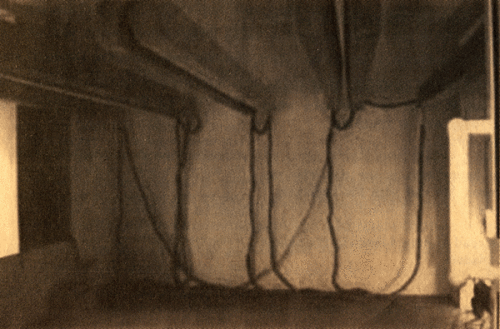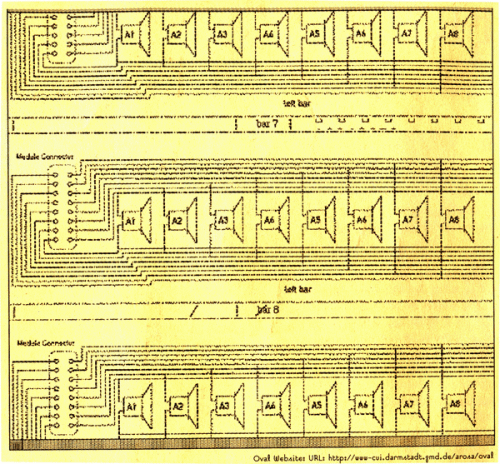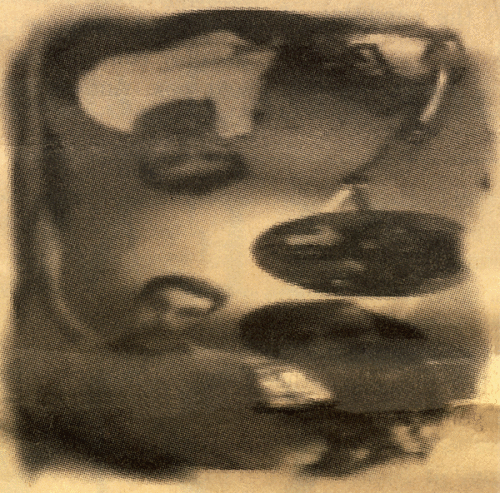Audioshop: Is it music or is it still time?
Subtle forms of technologically written music, as can be found in the mid 90's, demonstrate that through the use of the product (CD) the characteristics of its fabrication process (to store, coordinate and edit data) can be achieved, following the same or similar technological conditions which underlie both assembly and reproduction. Music is produced as a statement which delivers within itself an "about music". In the ideal case, digital reproduction methods like sampling incorporate a kind of cultural practice which corresponds with its technological conditions, namely the capability to be re-applied.
The following musical projects can all be understood in one mode; their production of sound introduces new approaches and achievements into the discourse of the technological "writing" of digitally produced music; all agree on the explicit and implicit statements about the technical predispositions of music.

Just as sampling and digital reproduction methods challenge artistic authorship, so this music challenges emancipation and the economy of listening. The codes of digital reproduction and sampling in hard disc and desktop recording position the existence of the original on the outside and the inside of the source. Used data appears as a series without a genealogy.
The assumption that music is perceived not only as technological artefact but also as aesthetic form remains untouched. Sampling, for example, creates an economy of listening which enables the signs of its own alienation to be relished. Sampling functions as a machine which makes perception perceivable but which also creates acoustic deception. Because technical media bypass primary perception, deception makes competent judgement on the originating noise problematic. In sampling, this deception comes at the intersection of the heard and the calculated.
The aesthetic component of sound samples is closely linked to the perception of time. What happens then to the perceived time looped in a sample? Looping creates a repetition which is at the same time cyclic and linear. A spiral like movement repeating the past to gain a future, an open bow which can feed back its effect as its cause. At the same time alteration of this loop can create a change in the repetition which is calculable, but not necessarily perceivable. The reliability of anticipation based on an already perceived (rhythmical, metric, tonal, etc.) structure deteriorates. Probability emerges only as a function of the file, which re-appears as sound deriving from algorithms. This initiates a process of forgetting rather than of recalling.
Just as technical memories are increasingly designed as a function of forgetting rather than a function of recalling; cultural memory, when it is being projected through the reception, storage, and editing of sound samples, implies not the collective recalling but the singular forgetting. Therefore such music functions as "anti-memory" in which repetition forms a strategy of positive forgetting' (Daniel Charles) or "revolutionary forgetting" (Deleuze/Guattari).
Though not using digital recording methods then, Alvin Lucier demonstrated this in his "I'm sitting in a room". There, both the transformation of language into another non-lingual formalism and the concurrent shift of the signified were augmented through the reduction of expression. Because the structure of the loop is gradually altered throughout its repetition, forgetting is perfected to the extent that all recalling is erased (also the recalling of an "original"). In the same way that continuing technological development enables us to apply certain machine metaphors to complex cultural settings, the periphery of "techno/ambient/new-electronic listening music" terminology shows wirings which are connecting explicitly to Deleuze's/Guattari's work on deterritorialisation/reterritorialisation, muddled codes and syntheticised music. The Frankfurt label Mille plateaux is one of the platforms on which digitally reproduced, technically generated music is published with as much offensiveness as subtlety.
The last release on Mille plateaux, init ding, from the project Microstoria shows how an organic density, seemingly derived from a laboratory of dynamic and instable technical vegetation, can be created with un-organic means. Microstoria (Markus Popp from Oval and Jan St. Werner from Mouse from Mars) plant mossy sound lichen, music structures in the drive of bio-technical desiring machines. Tiny slow motion drops formulate circular waves in the basin of electro-acoustic winking. This is music from greeting cards of the year 2500. Yet it never loses itself in its glockenspiel indulgement. Linking itself always to an expanding universe, init ding is carried towards an almost Satie-like level of chamber music and an astoundingly abstract "composing".

The speaker becomes the scenery for a technical audio-play far beyond Programm-Musik, the music an almost intimate, fragmented Art of coming-out of-the-speaker which in parts reminds one of Bernhard Guenter's Un peu de neige salie, Toop/Eastley's Buried Dreams or at the other end of the spectrum Gordon Monahan's Music from nowhere or Speaker Swinging.
Popp, one half of microstoria, is a member of the Berlin-based Oval who in 1994 marked a new phase in the interpretation of the process and product of digital recording with their CD Systemisch (Mille plateaux). One of the methods used by Oval lies in the handling and modification of the origins of samples. CDs are worked on materially, with tape and pen, and immaterially, by skipping through pre-recorded loops on the CD player. This kind of modification (which can also be found with Nicolas Collins) no doubt has parallels. Christian Marclay's vinyl records come to mind, covering the floor and being individually marked by the scratches of people walking on them. The significant difference is that the actual handling of the CD, of the material origin, initiates a process which can not be manipulated and influenced as it happens, one which follows the rules of the CD laser and the nameless, immaterial digital code. Thus the effects of digital production and the effects of digital scanning in the CD player overlap. The edited and processed error function of such a CD leaves one to initially believe that the product itself is faulty. Only through interpretation does the ingenious recursiveness emerge in which the error function (also of former aesthetic categories) reveals itself as a demystification of the digital immateriality, opening up an infinite - because partly random - terrain for further work and thought.
By skipping, fast-forwarding (or sampling vinyl scratches, too) samples here are not like quotations, rather a channel through which data can function as a musical frame of reference. By re-coding the product into the process systemisch contemplates the level of comment it carries within it: the procedure and its product exist alongside one another. Following this thought the recent release diskont 94 (mille plateaux) can be understood as its own agenda, as comment on systemisch.

At Oval music appears as a trompe l'oreille in the space between technical implementation and the discursive connectedness of process and product, as a hybrid reference towards the aural docuverse it is heading for. The consequence of Oval is the ability to recursively influence the music oneself, when enjoying what in fact is not recallable; only then is the structure deconstructed to its condition: the un-discovering of the moment and the un-avoidability of technology used. So, if there is an emancipatory content in the systemic and technological space between affirmation and negation, it might be the recursiveness which defines these production methods: applying the principles of Oval onto Oval, throwing the effect back into a possible agenda: handling the Oval CDs, may it be with felt pen, with fast-forwarding, or even using the same hardware. From the vantage point of today, Oval appears as an important step towards a general and universal dispositional and modulating option of musical data in networks. Oval's questioning and their making available of discursive procedures is an essential intermediate step and a procedure in itself.
Jan St. Werner, the other half of Microstoria, has up to now gained a reputation for being connected to Mouse on Mars. The Cologne-based Mouse on Mars appeared in 94 with the CD Vulvaland (too pure) and recently released with Iaora Tahiti (too pure) a creation embracing slightly clownesque Can references, subtly deconstructed break-beats, an ironic richness of blending styles and decades and, throughout all, a sovereign handling of sound and rhythm that made some critics believe they had spotted Kraut-Dub at work.
Music here appears as the practical distribution of something theoretical which can not be communicated in any other way; it may well be about ordering the process of forgetting. Music as the keeping of a homoeopathic promise, an aesthetic placebo for the actual data performance. The sample-sweets handed out by Mouse on Mars resemble the pills in Stanislaw Lem's futurological congress: perfect machines for the fabricating of reality copies - and who complains when the GP hands out "sweets" if they soothe the pain? In that sense, Mouse on Mars seems primarily a form of practice through design; by pondering the responsibility for sound at the same time, this design has to be considered as an expression of communication which is 'speaking' through hearing. It implies that the design has to change if the communication has to. Slow (Gefriem Records) from '92 for example, is another project of Werner's in which samples are more open and rough than in Mouse on Mars, a practice which makes the process of production accessible in the product. To stick to Lem, we are dealing with another level of reality, possibly herbal sweets.
The consequence of this design method could be the necessity to supply the musical data output with a highly user friendly surface. This may manifest itself either in Oval's way of deconstructing the role of the user or in having Mouse on Mars hand out music in the shape of funny 3-D goggles with which to watch the binary code jump around. The design does not have to be restricted to the product but becomes mobile as a process, decentralised and aesthetically modulable.

In Christophe Charles' work Deposition Yokohama (Christophe Charles) the product of music understands itself as a network in which the amount of CDs distributed worldwide corresponds with the idea of a temporarily erected sound installation in Japan. Deposition Yokohama refers to John Cage's Roaratorio in which he used I Ching-based chance operations to design samples of 2293 soundscapes on locations and noises mentioned in Joyce's Finnegans Wake, editing them with the IRCAM multitrack system. Deriving from an interactive installation in Yokohama, the CD contains 26 single tracks which enable one to listen to the work in both modes, linear and shuffled. By dividing the concept of the work into the installation-part on one hand and the mobile CD-product on the other, the CD can be seen as a multiple - a part of a worldwide spread installation as well as part of an autonomous work on CD. Charles states that "the work of art is here returned to its audience, and thus escapes from the control of its maker and its administrators." By loosening the installation piece from its site-specificity, the CD can work out as a multiple musique d'ameublement, interpreting "deposition" as "interaction, multiplicity, interpenetration without obstruction, and make the experience of a form of society which does not remain under administration of authoritarianism and politico-economical power." One principle of Deposition Yokohama leads to an attempt to make as many units as possible musically accessible, to finally format music as usable data. The CD medium has its boundaries there where the shuffle-button appears as the last option of the culture industry or as the best option for the decentralisation of listening.
Momentarily the best approach towards samples is to present them as viruses. Otomo Yoshihide's The Night before the Death of the Sampling Virus (Extreme) consists of altogether 77 tracks of origin-samples which circularly refer to exhausted sound surfaces, electronic entertainment achievements and broadcasting inanities. Music which makes answering machines jump start. Yoshihide offers an invitation to play the tracks in varying order, to avoid the chronological order of 1 to 77. The idea of constructing tracks as viruses finally clarifies itself when the CD jams at track 44. Is it due to the kind of listening? Or is it due to a refusal to follow Yoshihide's request to massively sample this CD: "Playing this s CD through as regular music may cause s the viruses to perish or change in quality." Consequently the viruses are named after the type of hardware they emerge from - Nintendo, Sega, Sony and so on.
In Yoshihide's sometimes archaic sampling methods (e.g. boiling records) he intends "to lay bare the act of sampling itself, not to create a musical work." In that sense the viruses are a categorical invitation to alter the sound structures of the CD - to play the CD in parallel to other sources of sound, to play it in fast-forward mode, to scratch it, and finally for maximum effectiveness to sample viruses from it: "What is important to remember is that the user is the one to decide how they are to be utilised. And, of course, how they are to be executed (killed)."
Such a user friendly interface once again tests the emancipatory character of production within the "economy of listening". Increasingly, music on the periphery of Techno seems to be concerned with a productive kind of self-definition. Meanwhile a production technique such as sampling has gained its own history as an excellent device for the questioning and challenging of technological production methods. Sampling has reached a degree of abstraction that has enabled the uncovered form to become its own structural content, to become decollaged. The question as to what extent such discursive and connectable music represents a subversive statement should rather be concerned with whether this subversion is a technical effect of the software/hardware used in its making. Would this prove to be a technologically deterministic view or, on the other hand, a strategy towards an affirmative overcoding that could work out to lead some elements of the underground into cultural (re-)production?
Mute Books Orders
For Mute Books distribution contact Anagram Books
contact@anagrambooks.com
For online purchases visit anagrambooks.com






